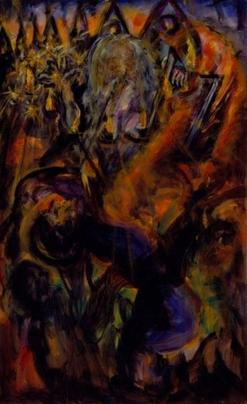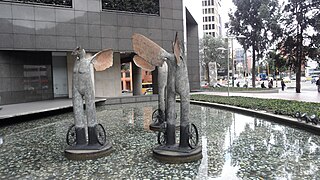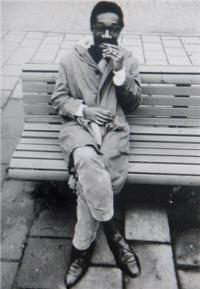
Beirut is the capital and largest city of Lebanon. As of 2014, Greater Beirut has a population of 2.5 million, which makes it the third-largest city in the Levant region and the thirteenth-largest in the Arab world. The city is situated on a peninsula at the midpoint of Lebanon's Mediterranean coast. Beirut has been inhabited for more than 5,000 years, making it one of the oldest cities in the world.

Paul Klee was a Swiss-born German artist. His highly individual style was influenced by movements in art that included expressionism, cubism, and surrealism. Klee was a natural draftsman who experimented with and eventually deeply explored color theory, writing about it extensively; his lectures Writings on Form and Design Theory, published in English as the Paul Klee Notebooks, are held to be as important for modern art as Leonardo da Vinci's A Treatise on Painting was for the Renaissance. He and his colleague, Russian painter Wassily Kandinsky, both taught at the Bauhaus school of art, design and architecture in Germany. His works reflect his dry humor and his sometimes childlike perspective, his personal moods and beliefs, and his musicality.

Watercolor or watercolour, also aquarelle, is a painting method in which the paints are made of pigments suspended in a water-based solution. Watercolor refers to both the medium and the resulting artwork. Aquarelles painted with water-soluble colored ink instead of modern water colors are called aquarellum atramento by experts. However, this term has now tended to pass out of use.
Events from the year 1973 in art.

Reginald Marsh was an American painter, born in Paris, most notable for his depictions of life in New York City in the 1920s and 1930s. Crowded Coney Island beach scenes, popular entertainments such as vaudeville and burlesque, women, and jobless men on the Bowery are subjects that reappear throughout his work. He painted in egg tempera and in oils, and produced many watercolors, ink and ink wash drawings, and prints.

Martyrs' Square, historically known as "Al Burj" or "Place des Cannons", is the historical central public square of Beirut, Lebanon.

Armenians have lived in Lebanon for centuries. According to Minority Rights Group International, there are 156,000 Armenians in Lebanon, around 4% of the population. Prior to the Lebanese Civil War, the number was higher, but the community lost a portion of its population to emigration.

The Beirut Central District is the historical and geographical core of Beirut, the capital of Lebanon. Also called downtown Beirut, it has been described the “vibrant financial, commercial, and administrative hub of the country.” It is thousands of years old, traditionally a focus of business, finance, culture and leisure.
Place des Martyrs may refer to:

Nabil Kanso was an American painter. Kanso began his career in 1968, New York during the start of the neo-expressionist movement. His works dealt with contemporary, historical and literary themes, and were marked by figurative imagery executed with spontaneous and vigorous handling of the paint and often done on large-scale formats. They reflected movement and tension embodying intense colors and symbolic forms addressing social, political, and war issues. The Vietnam War and the Lebanese Civil War profoundly affected the development and scope of his themes dealing with violence and war. His long-running Split of Life series encompassed an extensive range of enormous paintings depicting scenes of human brutality and suffering.

The Split of Life is a series of over 80 mural size oil paintings by Nabil Kanso. The paintings span a period from 1974 to 1994, and deal with contemporary and historical issues of war and violence.

Faust is a series of approximately 100 paintings created between 1976 and 1979 by Nabil Kanso. The paintings depict figural compositions in a sequence of scenes whose subjects are loosely based on Goethe’s 1808 play Faust Part One and Part Two.

Othello is a series of paintings executed in 1985 by Nabil Kanso. The subjects of the paintings are loosely based on Shakespeare’s tragedy Othello. The series comprises 60 paintings dealing with themes of love, race, jealousy, betrayal, and evil. They depict scenes embodying compositions of figural and metaphorical imagery that may be seen as visually reflecting the intimate and dramatic relationship between Othello and Desdemona, and the tense and uneasy relation that passes between and through Othello, Desdemona and Iago.

The Apocalypse Series encompasses 125 works consisting of 75 paintings and 50 drawings created between 1982 and 1984 by Nabil Kanso. The subjects of the works in the series are based on the Revelation of Saint John the Evangelist. The colors of this painting are somber, suggesting richness and heaviness, while the repetitive geometry of the shapes suggest apocalyptic inevitability. In Peran Erminy's article, The Apocalyptic Paintings of Nabil Kanso, he clearly states that Kanso's paintings portray our world today. He states that our world is constantly surrounded by violence and people feel vulnerable. The aggression one has can ultimately lead to a break out in war where the world will be doomed. Kanso's paintings reflect the path we are taking as a world. People today are quick to act upon threats leading us into a world that is ruled by war. This will be the hell on earth made by none other than human beings themselves. Kanso has a strong, intense effect on his audience's feelings and emotions. Kanso's work is dark and sometimes frightening, conveying how it is relevant to the scary obstacles of today's world. Our society seems to be stuck on depressing violence and aggression and if continued on this path, will only continue to result in tragic wars.
Aref El Rayess was a Lebanese painter and sculptor.

The Petit Serail was a historic administrative Ottoman building in Beirut that housed the seat of the Wali of Syria and Beirut. It was situated to the northern side of Martyrs' Square at the heart of the Beirut Central District. The building was the scene of important historical events but plans to enlarge Beirut's main square led to its destruction in 1950. It was one of several Ottoman era building projects that shaped the architecture of Lebanon in Beirut.

Jim Amaral is an American-born Colombian artist known for his drawings and bronze sculptures. Over a career that spans more than half a century, Amaral has also been dedicated to painting, etchings, collages, furniture design, assemblages/objects, and artist’s books. The artist has been widely recognized for his draughtsmanship, the subtlety and refinement of his technique as well as his imaginative and cultured universe. As a constant experimenter, Amaral has developed a unique aesthetics and symbolism and therefore has never belonged to any style or movement in particular. However, his work has been linked, for example, to surrealism and ancient Greece (sculpture). His art is deeply rooted in the psychological realms of the human existence. Amaral has always been focused on the condition of the human being, especially the topic of death and the passing time. "I am only trying to understand the world, to live through my painting. I am trying to understand certain mysteries, such as the energies of life and death, the loneliness of a man (...) I paint what people can reflect upon, so that what stays with the spectator is not only the visual impact".

Guy Renne was a French painter, draughtsman, pastellist, engraver, sculptor. He was first a painter from Bourbonnais (Charroux), until his installation in Provence in Fontvieille, then in Arles where he would reside until his death.

Roland Ayers (1932–2014) was an African American watercolorist and printmaker. He is better known for his intricate drawings – black-ink figures of humans and nature intertwined in a dream-like state against a neutral backdrop. A poet and lover of jazz and books, he expressed his poetry through images rather than words, he often noted, and considered his artwork to be poetry.
















